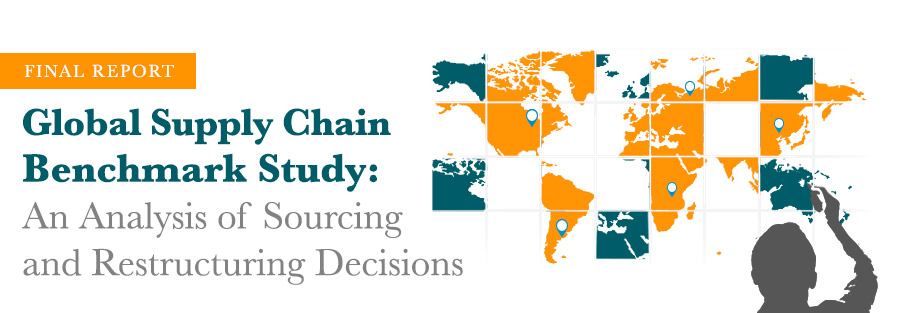Final Report: Global Supply Chain Benchmark Study
The Global Supply Chain Benchmarking Study is a joint effort of seven leading business schools, in North America, Europe, and Asia, investigating current global production sourcing decisions, the drivers of these decisions, and their observed or expected impact. A distinguishing feature of the survey, compared to other studies, is the emphasis on the reporting of sourcing strategies that were actively being pursued, as opposed to “intended” practices, which may or may not come to pass.
Results of the first phase of the project, presented in April 2015, revealed interesting insights into patterns of current sourcing decisions and the principal reasons companies are adopting these patterns. Most notable was the apparent debunking of two widely speculated sourcing trends: a weakening in China’s grip on the global share of low-cost production and a marked increase in the number of companies that are “reshoring” their manufacturing activities to North America. Our results showed that China continued to lead all regions in production volume growth by a substantial margin and the rate of production increase and decrease in North America was equal, indicating that the reshoring discussion was more hype than reality.
Our goal in the second phase of the research effort was to increase our response rate to determine if these results were, indeed, an accurate reflection of current sourcing trends. We were pleased to have more than doubled the size of our response pool in phase two, and while the total number of companies surveyed is relatively low, we feel confident that the quality of these respondents allows us to draw credible inferences from their experiences.
One of the most interesting outputs of this survey is something of a non-result. Upon examination of all responses, we were not able to identify a dominant production sourcing strategy. We believe this indicates that the “herd” mentality, which led so many companies to offshore production to low-cost countries in the early 2000s, may have finally given way to a more critical consideration of the total cost of these sourcing decisions.
We found that not only was there a greater variety of strategies being employed, but the reasons driving these choices were significantly less focused on labor costs than they had been in the past. For example, companies shifting production volume from Western Europe to China are most strongly driven by market changes including proximity to market, logistic costs, and delivery lead-time. While these companies deem cost and quality important, it is no more so than for companies following other strategies. For those companies increasing production volume in China, without any other reallocations, product quality and supply chain related factors, like delivery lead-time and flexibility, were dominant drivers.
The final survey analysis confirmed the two big takeaways from phase one. Despite anecdotal suggestions that rising labor rates were prompting companies to move their high volume manufacturing from China to other low-cost regions in Asia and Eastern Europe, China remains the most popular destination for production investments. However, cost is no longer the singular motivation for this strategy. Market access, quality and supply chain performance have emerged as dominant drivers for increasing production volume in China. While the results do indicate some shifting in production volumes, particularly in certain industries such as apparel, they clearly dispel the idea that manufacturers are leaving China in droves.
Our phase-two survey results, showing overall positive net growth in production activity in North America, seem to contradict the phase one report of an equal rate of production increase and decrease in the region. However, in both segments of the study, the majority of the firms that increased production in North America are non-U.S.-based companies seeking to increase their presence in the U.S. for market and innovation purposes. This cannot, therefore, be characterized as a “repatriation” of manufacturing activity to the Americas through reshoring.
The Benchmark Consortium committee defined two distinct categories of production shifts: rebalancing or reloading. Rebalancing through either reshoring or offshoring means that one country’s gain is another country’s loss. Reloading, on the other hand, signifies that an increase in production activity in one region is not associated with a decrease in another.
A general breakdown of regional changes in production sourcing is as follows:
- Reloading: China, India, and Europe are the primary regions with changes in volume driven by volume growth.
- Rebalancing: China, North America, and Europe are the primary regions with changes in volume driven by volume shifting.
A few additional findings:
- Eastern Europe/Russia is the second most attractive region for offshoring. Especially for firms from Western Europe seeking the cost advantages of nearshoring.
- Western Europe is the region with the largest outflow of production volume and one of only two regions in our sample with a negative net effect on production volume. The machinery sector, however, continues to invest in capital-intensive production in Western Europe.
- The risk of natural disaster has prompted many companies to shift manufacturing activity out of Japan, however, the Asian firms with a strong commercial focus on Japan and ASEAN countries are increasing production volumes in the “Land of the Rising Sun.”
The Consortium’s next step is to develop an in-depth analysis of the survey results that will focus on managerial lessons. The Consortium is also looking to repeat the survey with a broader industrial base and is interested in adding academic members to the team.
Related Resources:
- Executive Education: Supply Chain Leadership Program @ WHU – Otto Beisheim School of Management
- Seminar: “Supply Chain Excellence at Boeing” @ Boeing Center for Technology, Information, and Manufacturing, Washington University St. Louis
- Paper: Horizontal Coordinating Contracts in the Semiconductor Industry
- Book: Designing and Controlling the Outsourced Supply Chain by Andy Tsay
- Paper: Global Operations Sourcing Strategy: A Chinese Perspective
- Article: Q&A with Hau Lee
- Publication: Journal of Globalization, Competitiveness and Governability
